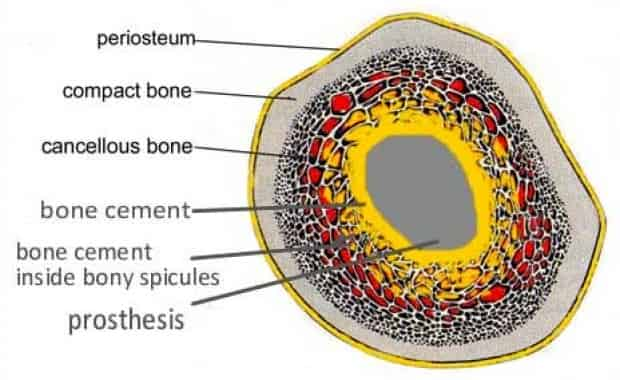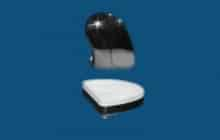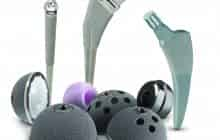
During a hip replacement, the head of the femur is removed. A metal stem is inserted and a ball fitted on top of the stem to replace the head of the femur. A metal liner or cup is then placed in the acetabulum and may be fixed with 2 or 3 screws. Into this is placed a plastic, metal or ceramic liner. The ball then fits into the cup, creating the new hip joint.
Fixed Bearing Hip Implants
The great majority of hip replacement implants are fixed bearing, meaning that there is a stem that inserts into the femur, a ball that replaces the head of the femur or top of the thigh bone, and a shell that is fixed and lines the hip socket (acetabulum). One manufacturer though now makes a mobile-bearing hip implant as well.
The major differences between implants are materials (metal, polyethylene and ceramic) and fixation. In terms of fixation, your surgeon will anchor the hip implant components to bone using either cement fixation or fixation by ‘bone ingrowth’ (cementless fixation) – or a hybrid of the two.
Hybrid Total Hip Implants
A hybrid total hip replacement implant has one component, which could be either cup or stem, inserted without cement. The other component is inserted with cement. Both types have a solid track record for stability and limited problems in the long-term.
Mobile-Bearing Total Hip Implants
Although most hip implants are a fixed-bearing design, some are of a mobile-bearing hip implant design which features an insert that is designed to fit snugly into the acetabular shell yet can move a little as the hip moves.
(CeramTec)
The hip joint then has two points of articulation or movement, essentially a ball within a synthetic socket, which resides within the natural hip socket. The liner is not secured into the acetabular shell but loose-fitted so it can glide smoothly between the ball and the shell.
This allows for multi-directional movement and an increased range of motion. The buffer also results in less friction and lower wear. The manufacturer of this implant suggests that the insert allows also for increased joint stability.
Total Hip Implant Fixation (Cemented or Cementless)
Cemented Fixation
Cemented fixation uses an acrylic polymer called polymethylmethacrylate (PMMA) to affix the prosthesis to the remaining bone surface.
When inserting a prosthesis into bone, both the bone and the cement must lock together in order to make the insertion last. Bone cement is not glue and it doesn’t stick to anything. It simply acts as a filler between the bone and the implant. In order to be dependable, it has to extrude into the honeycomb structure of the internal bone.
Cement is a durable and hard substance, much like metal. Bone, of course, is organic. It can be weak in small particles and easily fragmented. If the cement sits atop of the honeycomb inside of the bone, the pressure from the cement and/or the prosthesis can cause these somewhat delicate spicules to break off and die back, leaving a space between the bone and the cement. This is referred to as loosening.
In order to prevent this, a technique is employed whereby the cement is forced into the spaces between the bony spicules. When the cement sets three things result:
- the load and pressure of the prosthesis and the patient’s activity is spread over a much larger area
- the fragile bone is encompassed and protected by the cement so it doesn’t die back
- the cement is securely locked into the bone
To do this, the surgeon will flush out all the fat, blood and bone debris from that honeycomb with a special surgical power washer called a pulse lavage. Then the area is thoroughly dried before the bone cement is inserted under pressure.
The cemented bond is generally very durable and reliable with a considerable and successful history of usage. A patient with a cemented total hip replacement can put his/her full bodyweight on the limb and walk without support almost immediately after surgery. Patients can usually walk without support within three to six weeks post-surgery.
Complications are relatively unusual. Most patients with cemented implants experience no problems post-surgery.
Cementless Fixation
Within the last several decades, new implant designs have been approved that allow attachment to the bone without cement. These implants are generally larger and longer than those affixed with cement.
Most cementless hip implants are textured or have a porous surface coating around much of the implant that allows new bone to grow into the surface of the implant. Because they depend on new bone growth for stability, cementless implants require a longer healing time than cemented replacements (generally about eight weeks before walking without support for some surgeons; others may permit immediate weight bearing) and are not recommended for those patients with osteoporosis.
The Decision
How do you determine the kind of implant that is best for you? Talk with your surgeon about which implant will work best for your body and lifestyle. He or she will take those factors into account as well as his or her experience and preference with a particular implant design. The final choice of implant will be based upon health factors specific to you as well as your surgeon’s experience, education and expertise with the specific manufacturer’s products. Be sure to talk with your surgeon about which implant type he or she intends to use in your hip replacement and the reasons for the specific implant chosen.
Although the decision is ultimately your surgeon’s, you are well-advised to have a working understanding of the available options in order to understand the recommendations your surgeon will make, as well as the reasons for your recovery and discharge instructions.
Filed Under: Hip ReplacementHip Implants





